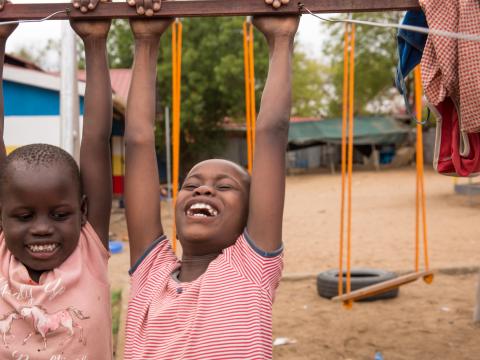The 43rd G7 Summit: Things to know

At the end of this week, the world will turn its eyes to Italy, as the annual G7 Summit takes place in Taormina, Sicily. This will be the 43rd annual meeting of the Group, and comes at a critical time as the world faces a growing hunger crisis driven in large part by conflict and climate related disasters.
Coming out of this year’s summit, we want the G7 to invest more in food and nutrition security, track investments and outcomes, increase investments in smallholder farmers’ livelihoods and national safety nets, and respond immediately to the current unprecedented global hunger crisis.
Here are some G7 basics to give you a foundation for understanding the upcoming summit.
What is the G7?
The G7 (Group of Seven) is an annual summit of leaders from seven of the world’s largest economies: Prime Minister Trudeau of Canada, President Macron of France, Chancellor Merkle of Germany, Prime Minister Gentiloni of Italy, Prime Minister Abe of Japan, Prime Minister May of the United Kingdom and President Trump of the United States. While not an enumerated member, the European Union is also present at the G7 Summit, represented by President Juncker of the European Commission.
These summits have been held since 1975 and are an opportunity for leaders to make unified decisions that can impact our world for good. Topics often include: global economy, security and development issues. Beyond unified decisions, summits can be the start of financial commitments by individual countries, and political symbols for the direction of global efforts in ending some of the world’s most pressing issues.
Here are some of highlights from past summits:
At the 2005 Summit in Gleneagles, Scotland, the G8 leaders promised an increase of $50 billion in official development assistance by 2010 to fight global poverty in Africa.
At the 2009 Summit in L’Aquila, Italy, the G8 leaders created the L’Aquila Initiative, promising $22 billion in the fight against global hunger and food insecurity.
At the 2010 Summit in Muskoka, Canada, the G8 leaders created the Muskoka Initiative, promising $7.5 billion in the effort to end preventable child and maternal deaths. Also, it was the first time that the G8 leaders produced an “accountability report” to highlight progress on past development commitments.
At the 2012 Summit in Camp David, USA, Leaders committed to The New Alliance for Food Security and Nutrition to lift 50 million out of poverty in Africa over 10 years through increased support to agricultural development.
At the 2015 Summit in Schloss Elmau, Germany, the G7 made an unprecedented commitment toward building a hungerfree world committing to lifting 500 million people out of hunger and malnutrition by 2030. However, they didn’t create a framework of action to make this happen.
What did the G7 leaders commit to in 2016?
Last year, in Ise-Shima, Japan, the summit focused primarily on foreign policy, terrorism and conflict. G7 leaders made a commitment to “increase global assistance to meet immediate and long-term needs of refugees and other displaced persons…”.
The 2015 commitment to decrease hunger and malnutrition made in Elmau was restated, recognising 2016 to be an “important year to unify global efforts on food security and nutrition.” The approach set out by the G7 was to focus on 1) empowering women in agriculture and food systems, 2) improving nutrition through a people-centred approach, and 3) ensuring sustainability and resilience within agriculture and food systems. You can dive deeper into these commitments in the G7 Vision for Action on Food Security and Nutrition.
What will the G7 focus on during the 2017 summit?
The mission set forth by Italian Prime Minister Paolo Gentiloni, is “Building the Foundations of Renewed Trust”. Under this, there are three pillars:
Citizen Safety
Economic, Environmental and Social Sustainability and Reduction of Inequalities
Innovation, Skills and Labor in the Age of the Next Production Revolution
Food security is listed as a topic under the second pillar.
What do we want world leaders to accomplish?
In the Declaration from the 2015 Summit, the G7 committed to decreasing the number of people who go hungry daily by 500 million by 2030. Currently, there are four countries (Nigeria, South Sudan, Somalia and Yemen) at risk of famine. Globally, 108 million people were facing severe hunger at the start of 2017, a 35 per cent increase compared to the year before.
During the Taormina Summit this week, we want world leaders to take concrete action.
Invest more in food and nutrition security, in-line with country plans and targeting the poorest, most marginalised and vulnerable groups.
Track investments and outcomes in support of the G7’s accountability plan, with a specific emphasis on tracking contributions towards reducing child stunting and wasting.
Increase investments in sustainable and resilient smallholder farmers’ livelihoods and national-level safety nets. Additionally, ensure the most vulnerable children and their families have sufficient access to affordable, nutritious food year-round, even in the hardest-to-reach places.
Take immediate action to address unprecedented levels of acute hunger globally, specifically in taking action to avert the looming famines in Nigeria, South Sudan, Somalia and Yemen.
If G7 leaders deliver on their previous hunger-related commitments in Italy, the outcomes from the G7 Summit this year have the potential to avert the catastrophe of famine, save lives and make a significant impact in the global hunger crisis, now and in future.
Learn more by reading our policy report Famine: the end point of a global protection crisis.